ENCHIDOS: THE ESSENTIAL GUIDE TO PORTUGAL’S CURED SAUSAGES
Historically speaking, the Portuguese are masters at eating nose to tail. In spite of current day commercial demands, we still make sure to use every part of the animals we slaughter, particularly in the home context of more rural areas. It’s this zero waste mentality – first because of necessity and now because of the power of habit – that is behind Portugal’s range of enchidos, that is, our cured meats and sausages.
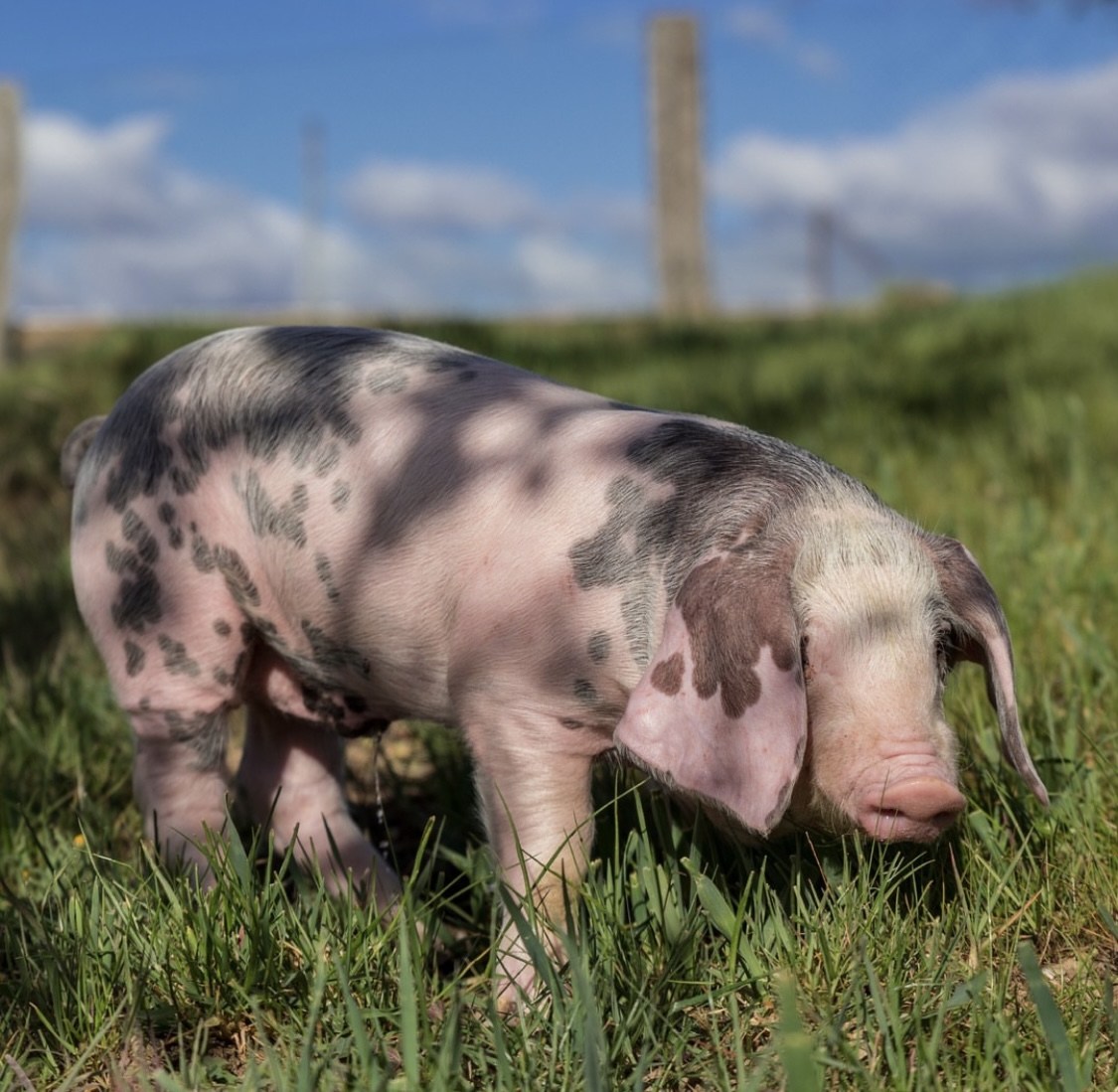
Bísaro pork at ‘Salsicharia Bísaro Traditional’, in Bragança.
The Portuguese have been eating pork in different forms for millenia, first wild boar and eventually domesticated animals. There are three autochthonous breeds of pig from Portugal, which currently have PDO (protected denomination of origin) status: Alentejano, which is the most popular Iberian black pig often referred to as porco preto; Bísaro, native to Minho and Trás-os-Montes regions in the north of the country, where there’s even an entire museum dedicated to pork; and Malhado de Alcobaça, which came about in the mid 1950 from mixing Bísaro pigs brought over from the Azores islands and fine bred English pigs. All these three varieties of pig are used for fresh cuts of meats as well as cured sausages, even though Iberian black pig (referred to in neighboring Spain as pata negra) is often the most complimented and prized because of the intensity of flavor thanks to the natural lifestyle of these pigs which range free in the Alentejo and have a diet of mostly acorns.
What is an “enchido”?
Enchido literally translates as “stuffed” and it stands for meats which have been prepared in various ways and stuffed inside pork tripe (or, to a lesser extent, other edible casings, including synthetic but edible ones in modern days). Enchidos came about from the need to use every single part of the animal, not only because historically no food could (and should) be wasted, but also because the matança do porco, that is, the pig slaughter would happen before winter would start, but was meant to yield enough food for the entire season.
The day of the slaughter was synonymous with feasting for families and neighbors, who would get together to kill the animal, make some dishes on the day itself and, while the meat was still fresh (particularly before the days of refrigeration), prepare it in various ways and cure it to last for months. Now-a-days, slaughtering pigs domestically is only allowed by the food hygiene and safety authorities if the meat is meant to be eaten by the same household where you sacrifice the animal. But, in reality, if you visit certain rural areas, you’d still be able to find home-made sausages which taste like no commercial counterpart ever could!
Portugal’s charcuterie: the most popular Portuguese sausages and cured meats
Summing up, enchidos are cured meats which resemble sausages, but that come in a variety of flavors and shapes. Even though enchidos are most commonly made with pork, Portugal’s cured sausages can also be prepared with other meats, as we are about to explore below.
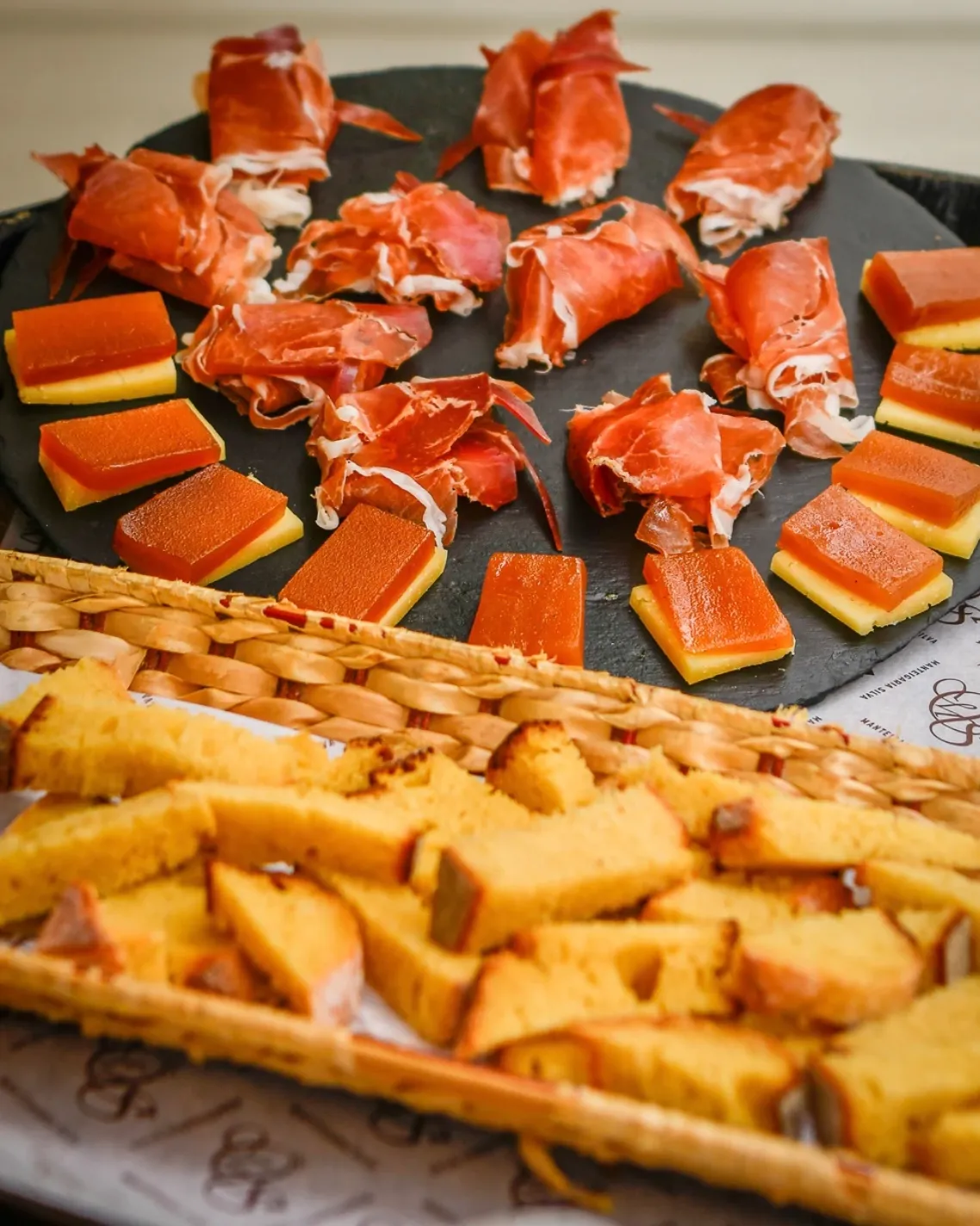
Portuguese ham served at our Ethnographic Food Tours (photo taken by our guest Diane Gordon, during a food tour)
Enchidos can be eaten plain on their own, such as featured in charcuterie boards (tábua de enchidos), sometimes also served with regional cheeses; grilled to be enjoyed with bread (this happens particularly with roasted chouriço); in sandwiches; or in chunks to add flavors to some of the most representative dishes of Portuguese cuisine, such as cozido à Portuguesa, feijoada beans stew, and other one pot wonder and stews.
Presunto, Portugal’s take on cured ham
When you travel to Portugal, cured ham, aka presunto, is one of the must-try local meats! The good news is that it’s fairly easy to come by, as it’s usually included in good charcuterie boards at wine bars, served in small platters in taverns, sliced into sandwiches at any given café or pastelaria, and you could also easily purchase it at a regular supermarket.
Presunto consists of a salted pig’s back leg which is left to cure and dry – sometimes it may be smoked, but not necessarily. Similarly to jamón in Spain or prosciutto in Italy, presunto’s curing process makes the meat change its flavor and texture too. Technically this is not cooked meat, but it’s cured to various degrees, depending on the length of time the pig’s leg is left to dry – usually, the longer, the better! The taste of presunto tends to be salty but, way beyond that, it is deeply flavored and aromatic.
Some of the most prized cured hams from Portugal include those from Vinhais, which have PGI (protected geographical indication) status, just like those from Melgaço, Barrancos and Barroso also do. Presunto do Alentejo has PDO (protected denomination of origin) status, as it’s exclusively produced with the meat from Alentejano breed of pigs, which have a unique color, aroma and texture.
The preparation of paleta follows the same process of presunto, but instead of being prepared with the back legs of the pig it features the front legs, which have less meat, are cured for less time than presunto and, thus, are cheaper too. To best enjoy cured ham or paleta, make sure your slices are cut thin, very thin!
Alheira: Portuguese Jewish history in the shape of a sausage
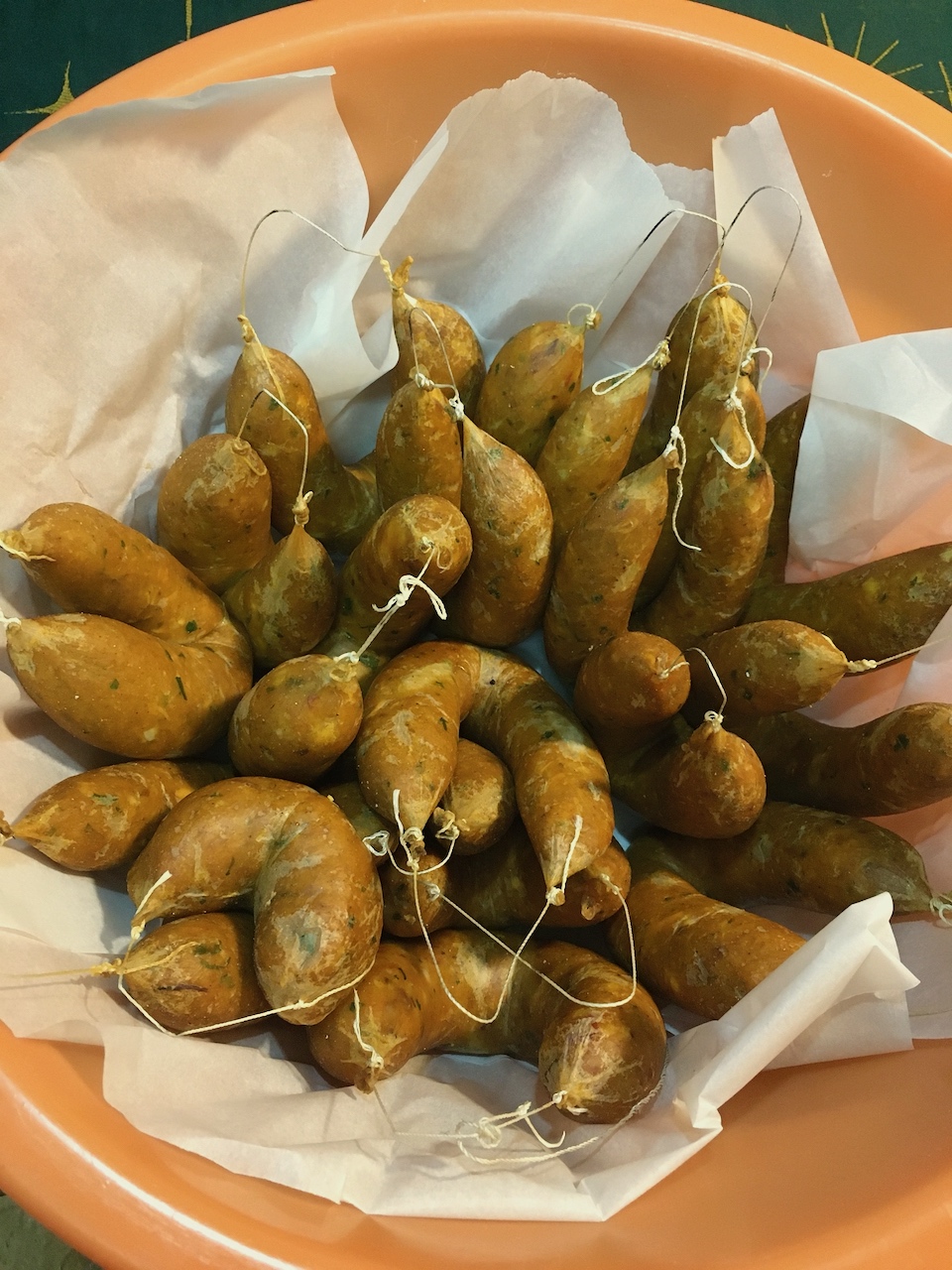
Homemade ‘alheiras’ ready to be smoked (by Chef Natacha Dias)
Out of all Portuguese cured sausages, alheira is quite possibly the most ingenious. The history of alheira is intrinsically linked with the history of Jewish oppression in the Iberian Peninsula.
Alheira hails from the northern region of Trás-os-Montes, and it’s prepared with a mix of meats, mashed bread, and seasoning such as garlic, alho in Portuguese, responsible for the name of this enchido. When you order an alheira now-a-days in Portugal, it will most likely be prepared with pork, or a mix of pork and chicken. But at their inception, alheiras were prepared with poultry and game meats and no pork whatsoever (today, those are called alheiras de caça).
Alheiras were initially developed by the Jews of Portugal during the days of the Inquisition back in the 15th century. During those times, the christian rulers would force everyone to convert to Catholicism and thus Jews were harrassed to abandon their faith and traditions associated with it. Many of these newly converted folks, now called New Christians, didn’t actually abandon their faith or habits, they simply made it look like they did. And this is how they came up with the idea of making alheira, a sausage prepared with poultry and game meats, agglomerated with bread and various seasonings, which was shaped to resemble a more typical pork sausage. Looking at alheiras being smoked hanging inside a (former) Jewish family home, anyone who’d come by would immediately assume that, eating pork (which is not kosher) this was indeed a newly christian family.
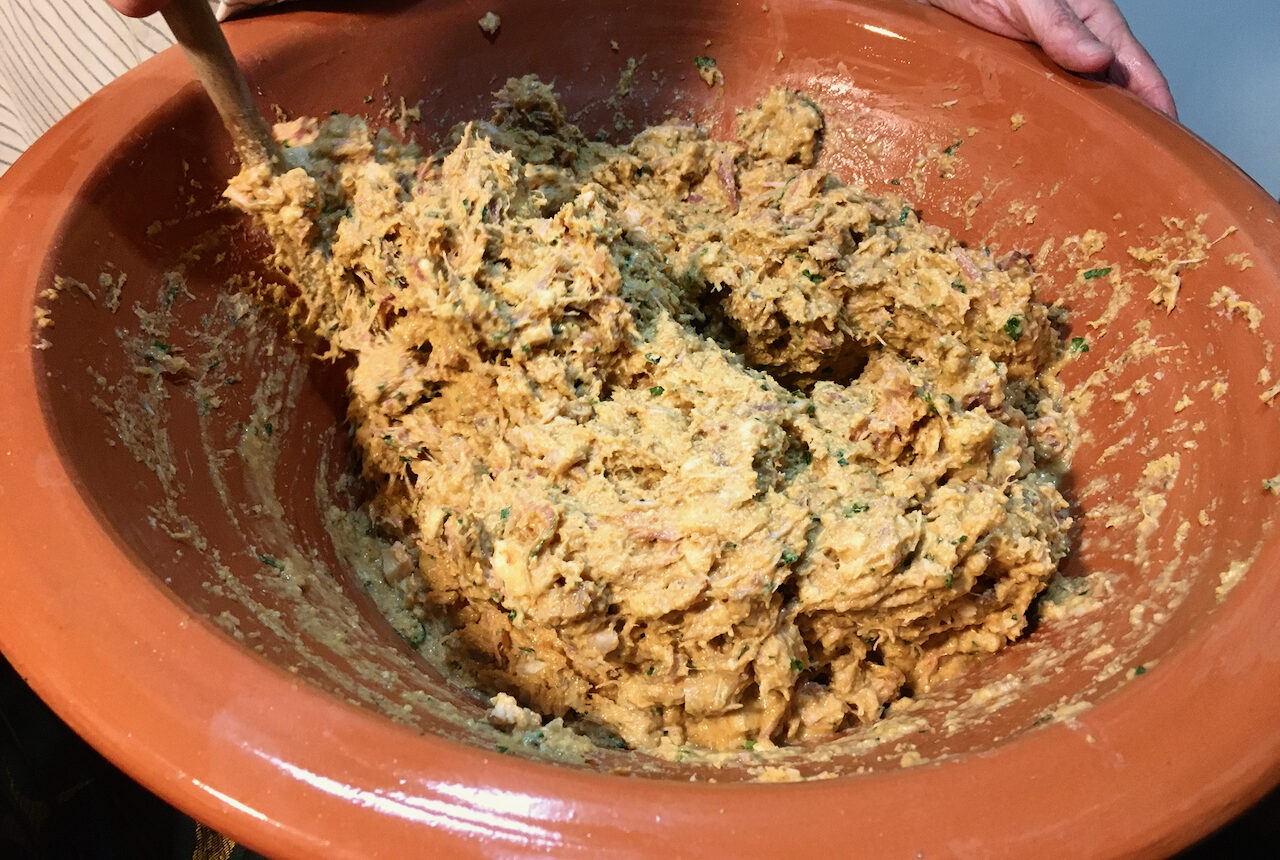
How to make ‘alheiras’ with Chef Natacha Dias and her mother
Portugal has been enjoying the flavor of alheira for almost half a millenia. In most Portuguese taverns you can order a grilled alheira, which would normally be served with potato fries and a fried egg or, sometimes, boiled potatoes and sauteed leafy vegetables, such as turnip greens. It can also be used to flavor other dishes like the stews we explore below.
As mentioned, unless stated otherwise, alheira is prepared with pork – something Jews who invented it centuries ago could probably never imagine it’d happen! For the game and poultry version ask for alheira de caça, which may contain a variety of meats such as rabbit, partridge, pheasant, duck and other poultry, and it’s a little more expensive than pork alheira. Alheiras with IGP status include those from Mirandela, Montalegre and Vinhais, which are all located in Trás-os-Montes.
Farinheira, a sausage with no meat!
Following the same principle as alheira, farinheira was also invented by the Portuguese Jewish community. Not only did it not contain pork back in the day, it didn’t even contain meat! Today’s farinheiras are prepared with pig’s fat (not actual meat), mashed together with wheat flour (farinha in Portuguese, explaining the same of this sausage), massa pimentão (tangy red pepper paste), white wine, garlic and salt. A variant of farinheira which makes use of corn flour instead of wheat is farinheira de milho de Monchique, from the Algarve municipality by the same name, where they can also add a hint of cinnamon to the sausage’s recipe.
Farinheira is not the type of cured meat you’d find in a charcuterie board. It’s usually used to enhance dishes (such as slowly simmered stews or simple scrambled eggs) more than being eaten on its own. Either way, you’re always meant to cook it and you can’t really slice it as it would disassemble. Its texture is crumbly because of the scratch content, and the flavor is savory and quite exquisite, after some time curing in a smokehouse or at home, hanging on a rod by the fireplace.
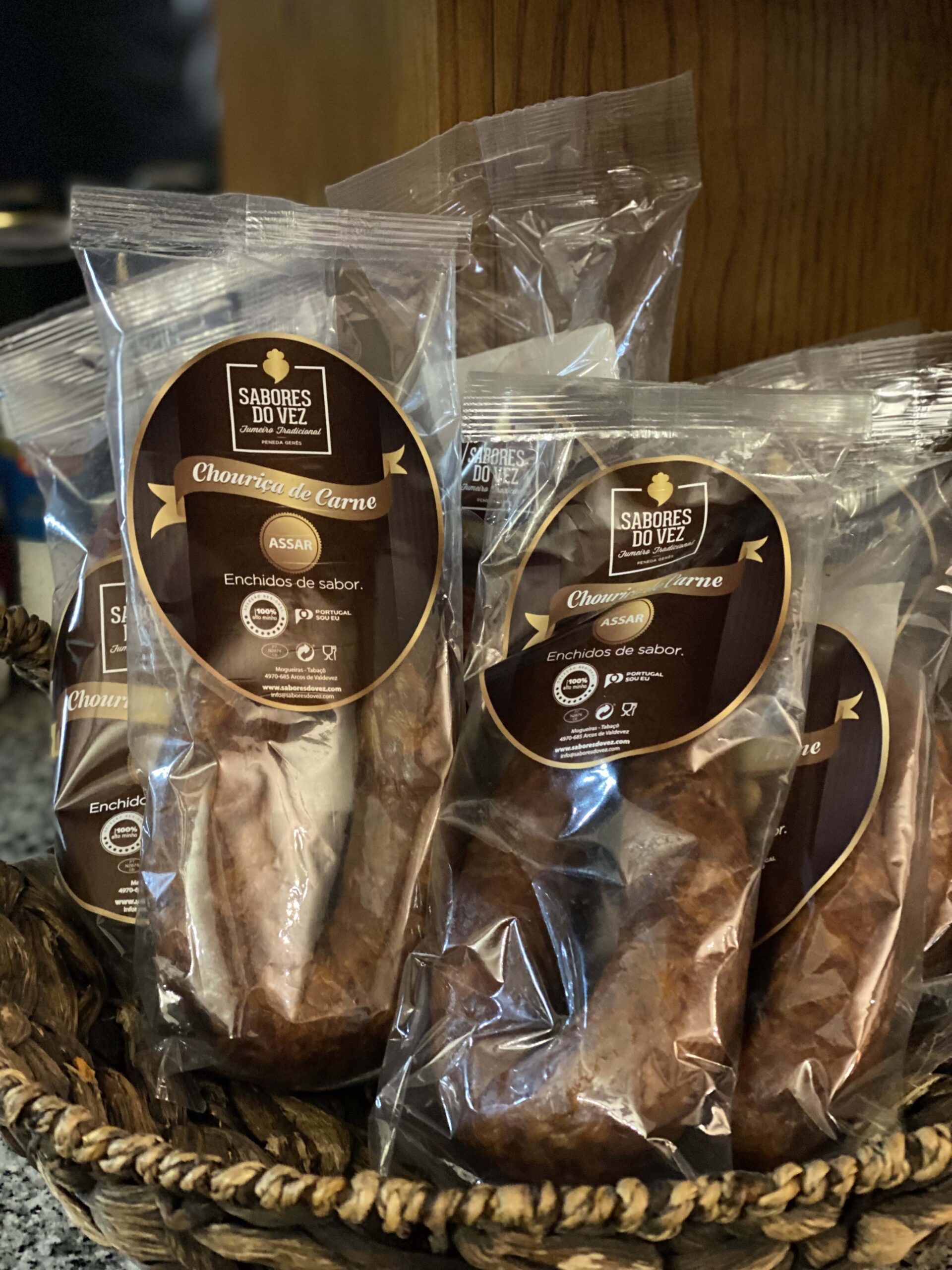
Artisanal ‘chouriças’ by Salsicharia Vez, using local green wine. A project by Vasco Lima we visited while in Arcos de Valdevez.
Chouriço: paprika infused goodness inside pork intestine casings
“Encher chouriços” is a funny Portuguese saying that literally translates as “stuffing chorizos” and that stands for filling time or something with useless stuff, aka, wasting time. Popular sayings aside, we’re so glad Portugal just loves to spend time stuffing chouriços of all sorts!
The term chouriço is rather broad as it may encompass different types of cured and smoked sausages, usually inside pork intestine casings. The fillings of a chorizo vary depending on the producer and region of the country and, besides the usual filling of pork meat (when it has more meat than fat it’s often referred to as chouriço de carne or chouriça de carne), fat, paprika, wine and garlic, so many other ingredients may actually make it inside a chorizo! In the south of Portugal you’ll find chouriço Mouro, a variety which is darker and browner than the usual chorizo, because of the use of bloody meat trimmings. Regular chorizo tends to be brighter red thanks to the addition of red pepper paste in the recipe. Fans of strong flavors will probably like chouriço de cebola, flavored with onions and parsley. Even though chorizo isn’t usually as salty as other enchidos, namely presunto, there are actual sweet(ish) varieties, such as chouriço doce de Vinhais, prepared with blood and honey, and chouriço de abóbora de Barroso-Montalegre, with pumpkin.
Chorizos have a fairly dry texture, as they’re left to cure and smoke for several days or even weeks. Like many other enchidos, chouriços can be used as part of recipes or inside sandwiches. But one of the most striking ways of eating these paprika infused smoky sausages is grilled, something which can even happen at your table when you order chouriço assado, also known as chouriço à bombeiro (firefighter style chorizo). The sausage is grilled over alcohol in a clay vessel specifically designed for this purpose, which is in Portuguese known as canoa, or canoe. Once the fat starts dripping, the flames are put out, the meat is cut into bite sized pieces and enjoyed with bread which soaks up the fat and flavor. Fancy trying this fiery treat? Join one of our ethnographic gastronomic experiences in Lisbon and you’ll see it and taste it with us (see the image below)!
The term chouriça is often used interchangeably with chouriço, but to properly recognize the difference between these sausages, we ought to recognize that chouriça is usually thicker than chouriço. Chourição is yet another cousin of chouriço, in this case thicker and longer, often less cured than chouriço, and which is usually eaten thinly sliced in sandwiches – you’ll see it featured in deli counters and regular supermarket charcuteries!
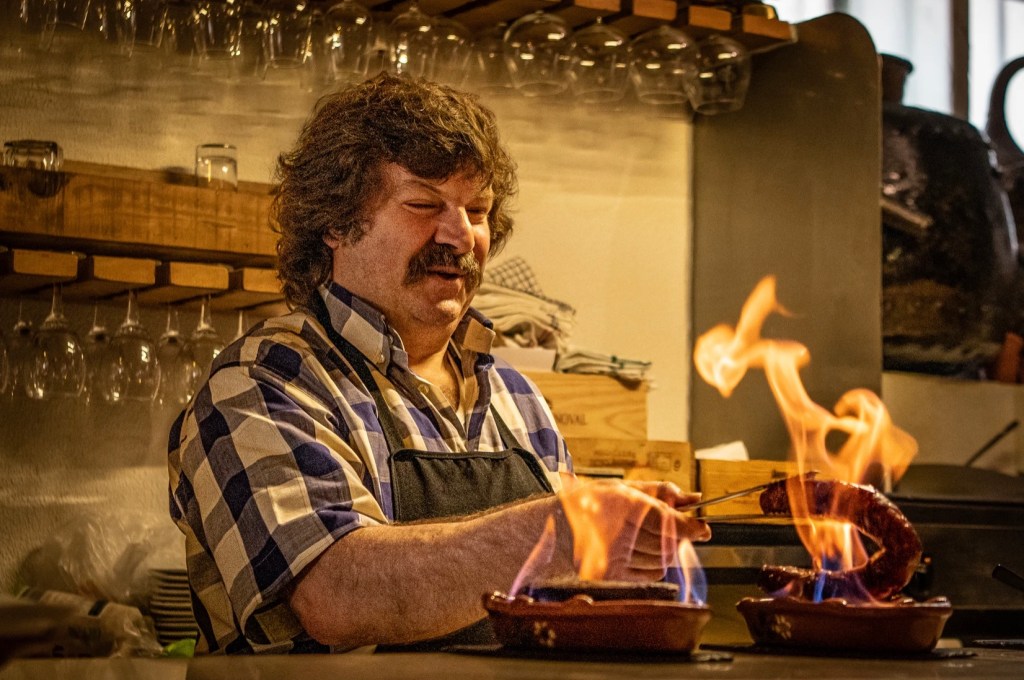
Armando grilling chorizos during our 17 Tastings Lisbon Ethnographic Food Tour (photo from our guest Diane Gordon)
Varieties of chorizo can often be found in territories worldwide where the Portuguese have had historical ties with. A good example of this is Goan sausage or Goan chouriço, in the former Portuguese territory of India, where the sausage is much spicier and condimented than its Portuguese counterpart.
Morcela, Portugal’s version of blood sausage
Many parts of the world prepare versions of blood sausage, such as blood pudding in the UK and Ireland, boudin noir in France or morcilla in Spain. Here in Portugal, bloody sausages are called morcelas!
 Portuguese blood sausage can be prepared differently depending on the region of the country. They all contain a little bit of pork meat, fat and pig’s blood. Variable ingredients include rice (morcela de arroz), bread and onions. For flavor development and preservation, morcelas are first steamed and then cured in the smokehouse, but they’re usually cooked again before being finally eaten. They can be incorporated into stews or even eaten as an appetizer grilled – we find that they taste particularly well served with tangy pineapple from the Azores, simply sliced and served raw or lightly caramelized, on the side or as a base for the morcela.
Portuguese blood sausage can be prepared differently depending on the region of the country. They all contain a little bit of pork meat, fat and pig’s blood. Variable ingredients include rice (morcela de arroz), bread and onions. For flavor development and preservation, morcelas are first steamed and then cured in the smokehouse, but they’re usually cooked again before being finally eaten. They can be incorporated into stews or even eaten as an appetizer grilled – we find that they taste particularly well served with tangy pineapple from the Azores, simply sliced and served raw or lightly caramelized, on the side or as a base for the morcela.
Even though this is a sausage which may sound intimidating to folks not used to eating food with blood, understand that it doesn’t taste straightforwardly bloody. Instead, morcela’s flavor is delicate, mildly nutty, very aromatic featuring a hint of cumin, which is great to cut through the intensity of the blood on the mouth, and its texture is soft and pleasant.
Some of the most famous types of morcela found around Portugal include PGI status varieties from Portalegre, Borba and Estremoz, in the Alentejo region. Personally, we’re particularly big fans of morcela do Pico, a type of blood sausage from this island in the Azores where we organize gastronomic and cultural trips to unveil some of the most well-kept culinary secrets of Portugal!
In the Minho region of Portugal you can also find moira, a type of morcela which includes more spices and is usually cured for longer, which is customarily eaten grilled with soupy rice dishes such as arroz de grelos (turnip greens rice).
Cacholeira, from the Alentejo, is also a closer relative of morcela, in terms of main ingredients and seasonings. The difference is that it uses pork liver instead of pork blood as a binding agent. Its name refers to the cachola, which is precisely the Portuguese word for pig’s liver.
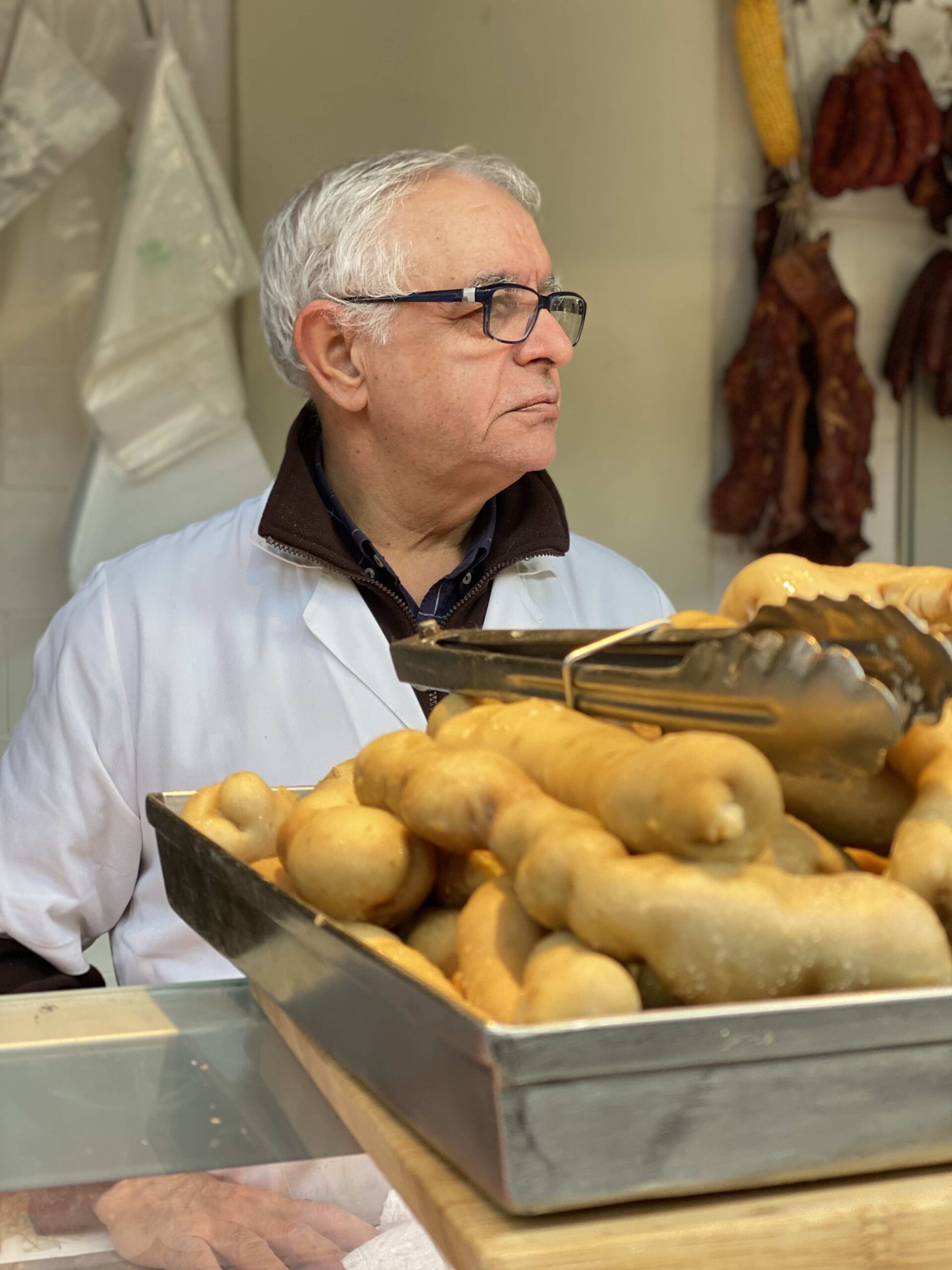
Bulhão market, one of the reputed ‘tripas’ seller (Salsicharia Luísa)
Tripa enfarinhada: pork tripe, flour and fat
Most of the enchidos we speak about here make very good use of pork tripe as casings for other meats or amalgamation of trimmings, fats and seasonings. But perhaps none highlights tripe as well as tripa enfarinhada (literally tripe with flour) does!
Typical from the northern regions of Minho and Douro, tripa enfarinhada is usually sold at traditional butcher shops within these regions, and you’d hardly ever come across it in other parts of Portugal. It’s a peculiarly shaped enchido, prepared with tripe, lard, corn flour (a typical ingredient from this region, also featured in one of the most beloved local baked goods, broa, aka cornbread) and seasonings like pepper and cumin. Tripa enfarinhada is eaten as a snack or appetizer, that is a petisco, after being fried and cut into round slices. It can also be served alongside rojões, a typical dish from these northern parts of Portugal, featuring fried cubes of pork and potatoes.
Unlike other enchidos, tripa enfarinhada isn’t air cured or smoked but there’s nothing that literally embodies the concept of enchido (remember this means stuffed), like this stuffed tripe does!
Paio, a prime cut of smoked pork loin
If you like cured sausages but enjoy leaner meats, ask for paio, a cured cut made from pork loin. Similarly to other pork enchidos, paio is flavored with garlic, sweet paprika, white wine and salt. Once it uses a prime cut of meat, paio is one of the most well-liked and prized of Portuguese enchidos.
Its flavor is mild but long-lasting, and its texture is drier and firmer than other sausages, as it indeed contains much less fat than the average Portuguese enchido. The most popular way of eating paio is as part of a charcuterie board or thinly sliced into sandwiches (sandes de paio).
Well-known varieties of paio in Portugal include PGI paio de Beja and paio de Barrancos, both from the Alentejo. In this region, when colloquially you’d like to say that a man has a big phallus, you would say he has a paio de Montoito, a type of sausage which isn’t particularly long, but tends to be rather thick.
Also in the Alentejo,we find paio branco, that is white paio, which is only seasoned with garlic and salt, thus explaining its paler appearance. To make paio branco the pork loin is seasoned and wrapped in peritoneum, which is the membrane found around the pig’s fat, and smoked for about a month with wood with local Alentejo trees such as the evergreen oak.
Painho or paioca takes inspiration from paio, but it’s a more affordable version of it, as instead of just using pork loin it includes pork cuts like belly, shoulders, neck and various trimmings, seasoned and stuffed inside pork casings and cured similarly to paio.
Salpicão, cured pork loin Trás-os-Montes style
Also prepared with pork loin, just like paio, salpicão is a thick smoked sausage from the region of Trás-os-Montes. This cured meat has been made for at least four centuries, and enjoyed sliced with bread as a snack or light meal. As this is not a fatty cold cut whatsoever, it’s perfect to thinly slice and eat as it is!
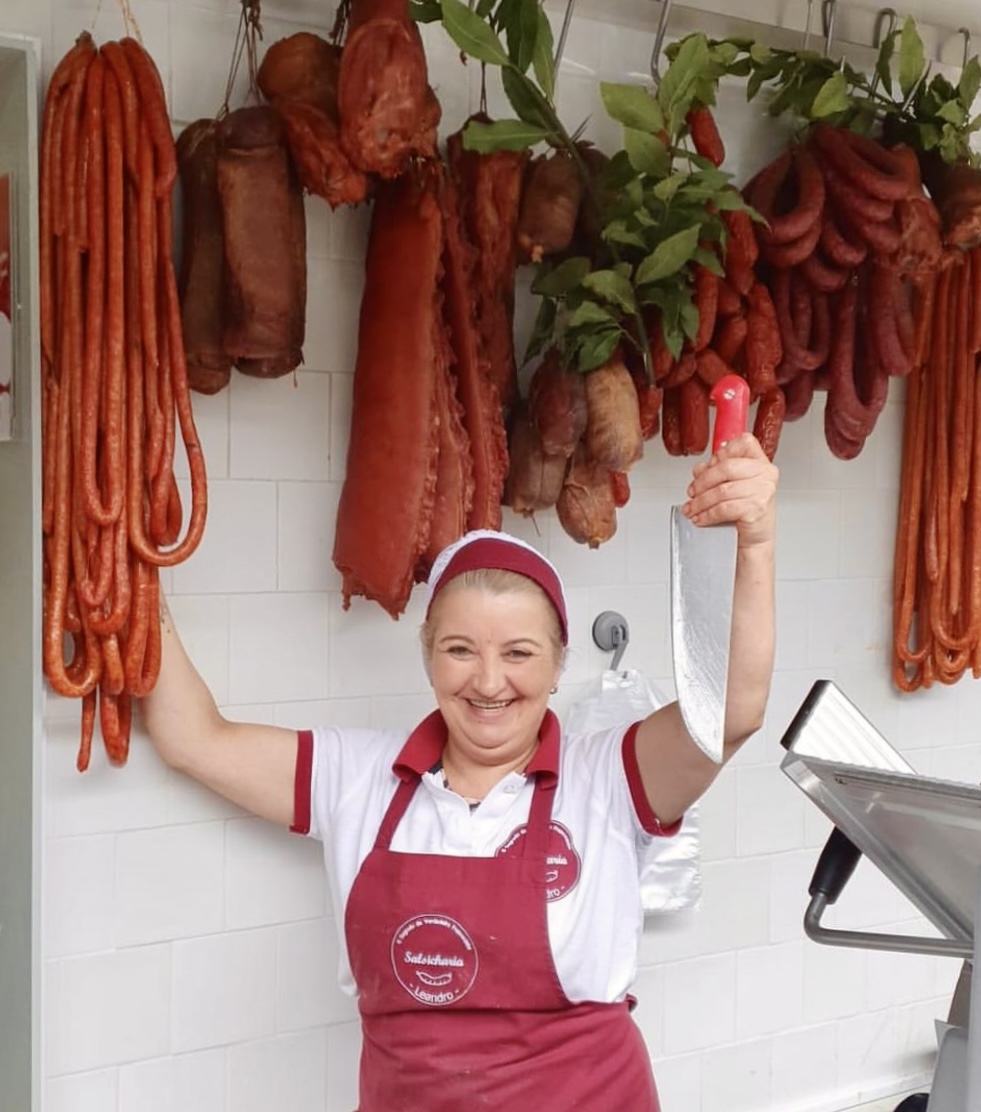
Salsicharia Leandro at ‘Bulhão Market’ (Porto). Their ‘linguiças’ are the ones typically used in Francesinha!
Besides pork loin, salpicão can also sometimes include pork leg in its composition, always seasoned with paprika, bay leaf, garlic, white wine and salt. The marinated ingredients for salpicão are stuffed inside the large intestine of the pig, wrapped with thread, and left in the smokehouse to slowly dry and develop depth of flavor.
Linguiça (also known as Portuguese sausage in Hawaii!)
Even though linguiça may at first look similar to a chouriço, which makes sense once this smoked sausage is also made from pork meat and fats, it’s usually shaped thinner. In terms of flavor it is also seasoned with paprika, garlic and white wine, but in lesser amounts than chouriço. As such, its taste is usually milder and, even though it can also be used to add flavor to dishes, it normally packs a little less of a punch.
Some American folks may already be familiar with Portuguese linguiça, even if they’ve never actually heard this name. Portuguese immigrants (mostly from the archipelagos of Azores and Madeira in the Atlantic) went to Hawaii in the 19th century to work in sugarcane plantations. With them they brought several recipes, including linguiça, which is now-a-days still popular in the islands and known as Portuguese sausage! It would be crazy for us here in Portugal to eat linguiça alongside pancakes and syrup first thing in the morning, but we love to see how linguiça evolved in Hawaii and has been incorporated alongside other habits to eventually become its own local thing!
The Portuguese also exported linguiça to Brazil after the Columbian Exchange of the 1500s, and this sausage is still very widely eaten all over the country today.
Meat, cartilage and bones make Butelo
Butelo is a large sausage prepared with meat from the backbone of the pig, including its bones and cartilage, stuffed inside the pig’s stomach (in Portuguese known as bucho). Even though it may sound odd at first to have an enchido with bones, understand that these are obviously cooked to a soft and edible consistency, which is actually pleasant to the palate. In any case, we can’t deny that, at least originally, the idea of butelo came about during times of scarcity, during which is was important to maximize the potential of every single ingredient, particularly in the area of Trás-os-Montes where butelo comes from, which historically was remote and, compared to the rest of the country, underdeveloped.
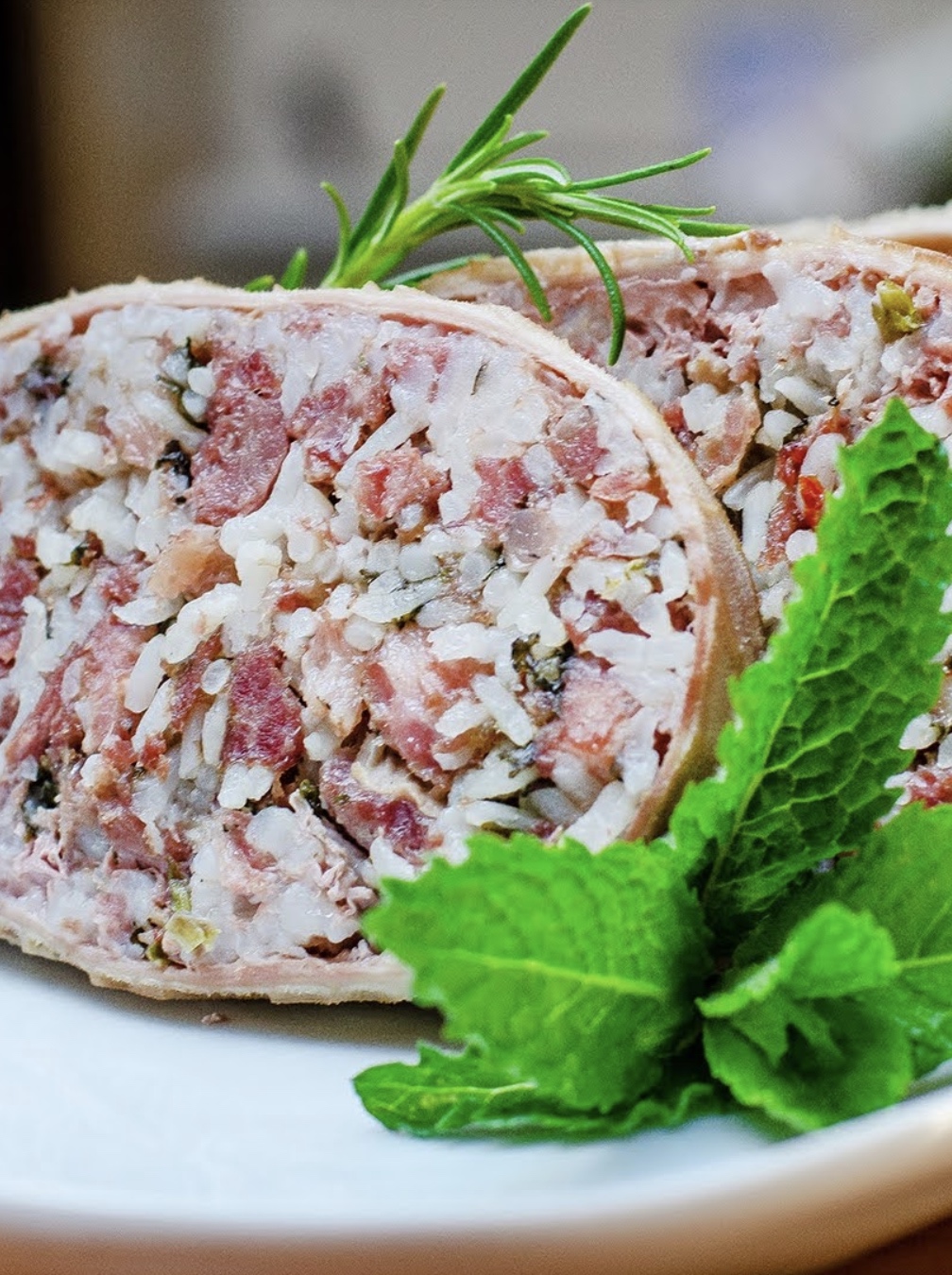
Maranho, from Sertã
The meat found around the pig’s bones might not be as abundant as in other parts of the animal, but it has a very strong and characteristic taste, which is what makes butelo a special enchido. Unlike other smoked and cured sausages, butelo doesn’t last as long, thus it’s most commonly eaten shortly after it’s prepared, somewhere between winter and, at the most, spring.
Butelo can also go by the names of bulho, chouriça de ossos (meaning bones chorizo) or palaio and if you ought to try only one type of butelo in Portugal, if possible, look for PGI butelo de Vinhais.
Maranho, stuffed goat or sheep stomach
Maranho is a food speciality from the Beiras region in Portugal. This is an enchido for once not made from pig but, in this case, prepared with goat’s stomach (bucho de cabra). The stomach is stuffed with goat’s meat and rice, and its taste is enhanced by adding cured ham, paprika and white wine. It sounds a little heavy but the flavor or maranho is balanced with herbs such as parsley and mint too. Once stuffed, the goat’s stomach is sewed and boiled until the ingredients inside are soft. It’s served sliced on the plate, with sides such as boiled potatoes and left greens
There is a non-profit organization called Real Confraria do Maranho, in Pampilhosa da Serra, district of Coimbra, which is responsible for keeping the tradition of making maranho alive and sharing the love for it with the rest of Portugal. The municipality of Sertã also puts together an annual gastronomic festival dedicated to maranho, Festival de Gastronomia do Maranho, where you can try PGI maranho da Sertã, a type of maranho which can be prepared with either goat or sheep.
Traditional Portuguese recipes which cured meats
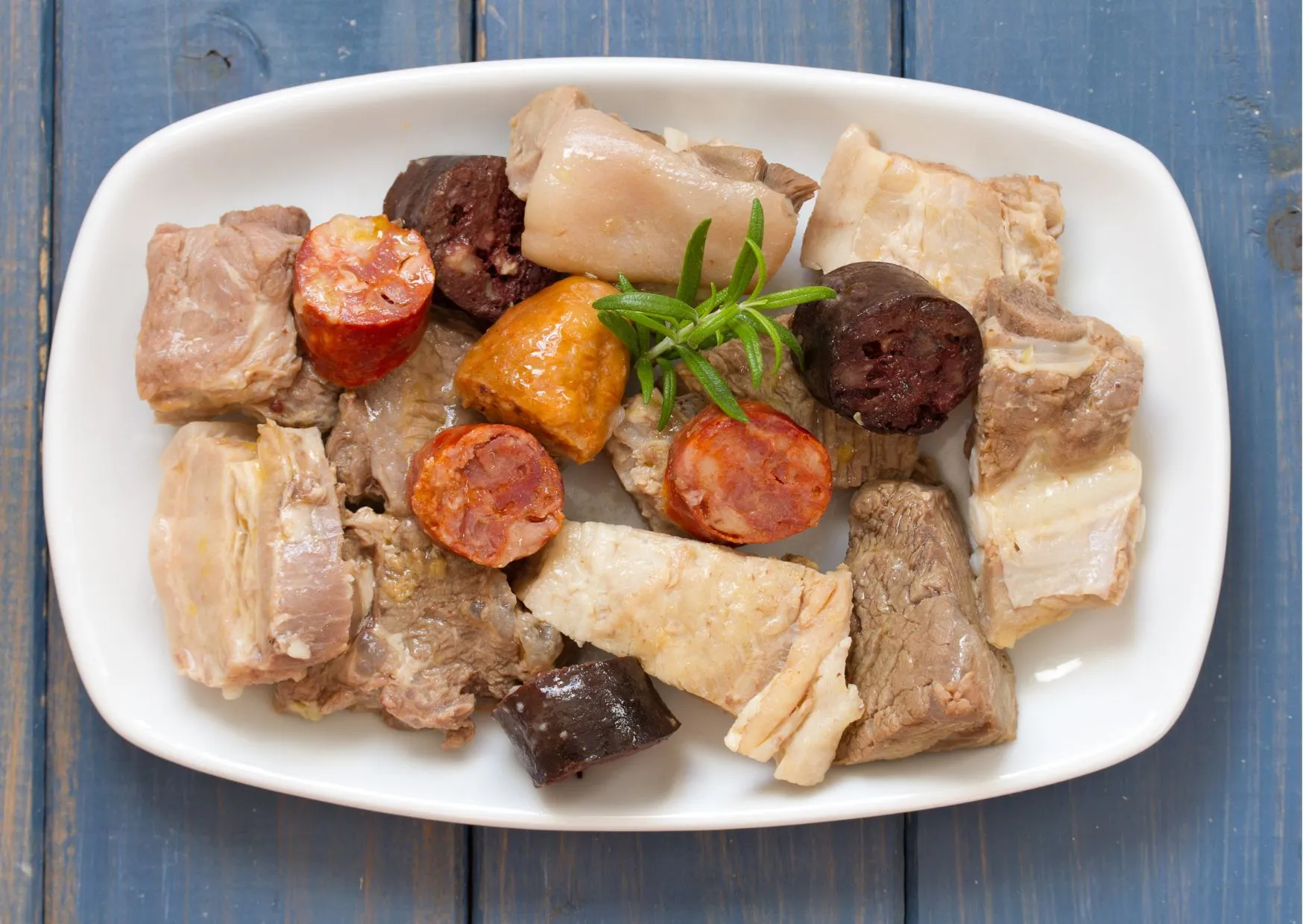
Meats and ‘enchidos’ in a typical ‘Cozido à Portuguesa’
Cured meats are responsible for some of the defining flavors of traditional Portuguese cooking. Not only do enchidos add nutritional value to otherwise humble stews, they most of all build on layers of flavor, thanks to their saltiness, smoky undertones and variable amounts of fat.
Some of Portugal’s most famous long lasting dishes include cured meats as part of the recipe. These are usually boiled meals, such as cozido à Portuguesa, a boiled dinner with meats, enchidos, vegetables (like potatoes, carrots, cabbage and turnips) beans and rice. Cozido à Portuguesa recipes may vary according to the cook and, particularly, depending on the region of Portugal where you’re eating this dish, as different regional enchidos are used based on where you are. Essential cured and smoked meats for cozido include chouriço, morcela, farinheira and presunto, which we’ve explored above, but also chispe, which is salted pork trotters, and orelheira, which follows the same curing method and applies it to pork ears. The true origins of this recipe can’t really be traced, as similar dishes have been cooked in southern Europe for many centuries (think of pot-au-feu in France or bollito misto in Italy), but there’s no arguing that cozido à Portuguesa is a defining dish of Portugal’s gastronomic heritage.
Today, the world largely associates feijoada to Brazil, but this dish has its origins in the northern mountainous Portuguese region of Trás-os-Montes [inserir aqui link para artigo sobre esta regiao], where similar stews with beans and a variety of cured meat cuts have been cooked for centuries. The basic principles of the dish were exported to Brazil during colonial times, eventually making use of other ingredients across the Atlantic, namely the use of black beans versus the more usual red kidney beans we cook feijoada
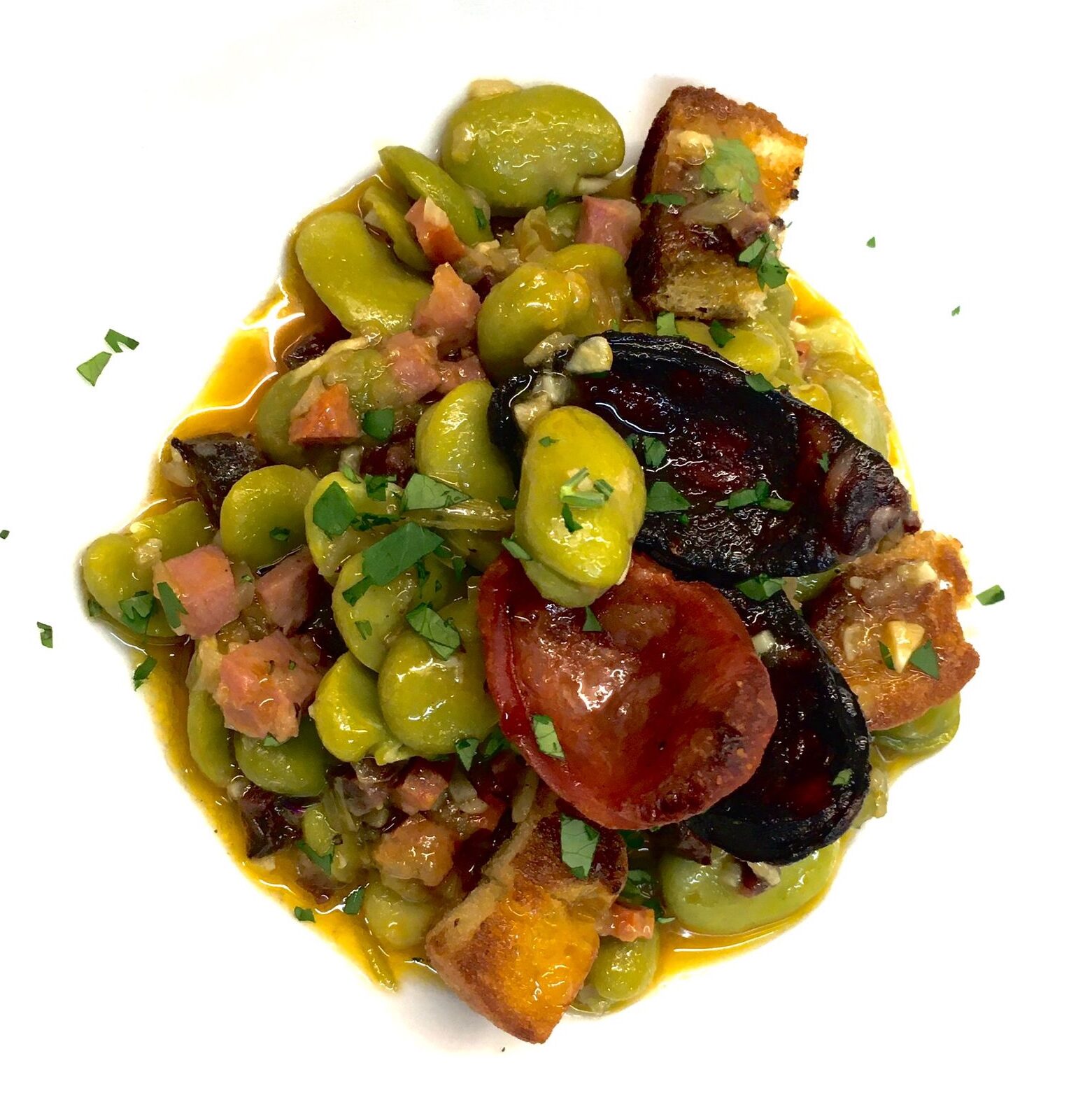
´Favas à Portuguesa´, cooked by Chef Natacha Dias (OMC host)
with here in Portugal. Beans aside, in Portugal, a good feijoada often includes cuts of pork and beef, and cured meats such as chouriço, morcela and/or farinheira. Traditionally feijoada à Transmontana also includes alheira, one of the most beloved sausages in the region, which adds even more depth of flavor to the dish.
Also hailing from Trás-os-Montes, perhaps Portugal’s most relevant region alongside the Alentejo, when it comes to the production of enchidos and their use in the local cuisine, is rancho, a stew with such an incredible variety of ingredients! Rancho gathers on the same pot potatoes, chickpeas, small pasta like macaroni, vegetables such as carrots and cabbage and, of course, cured meats like chouriço. Depending on the cook or region, the chouriço used for making rancho could be chouriço de carne or even blood chouriço (chouriço de sangue), and adding other cured meats like chispe or salted pig’s ear (orelheira) can also be a plus for even more flavor!
The northern city of Porto has tripas à Moda do Porto as its most traditional old-time dish. This Porto style stew features not only beef tripe and white beans, but just like the other recipes mentioned above, also includes cured meats for added flavor: chouriço, salpicão, presunto or toucinho (cured pork belly) are some of the favorites for this preparation.
Broad bean lovers can have a great time in Portugal as we’re masters at preparing hearty dishes with fava beans. Of course, enchidos are once again responsible for a lot of the flavor one can enjoy trying favas com entrecosto, a fava beans and ribs stew, often including chouriço too, which sometimes also goes by the name of favas à Portuguesa.
For a protein packed meal we’d recommend ovos com ervilhas, which features stewed green peas flavored with slices of chouriço (or sometimes linguiça), and poached eggs (ovos) on top. This is a fairly simple recipe but indeed a classic of the Portuguese cooking repertoire!
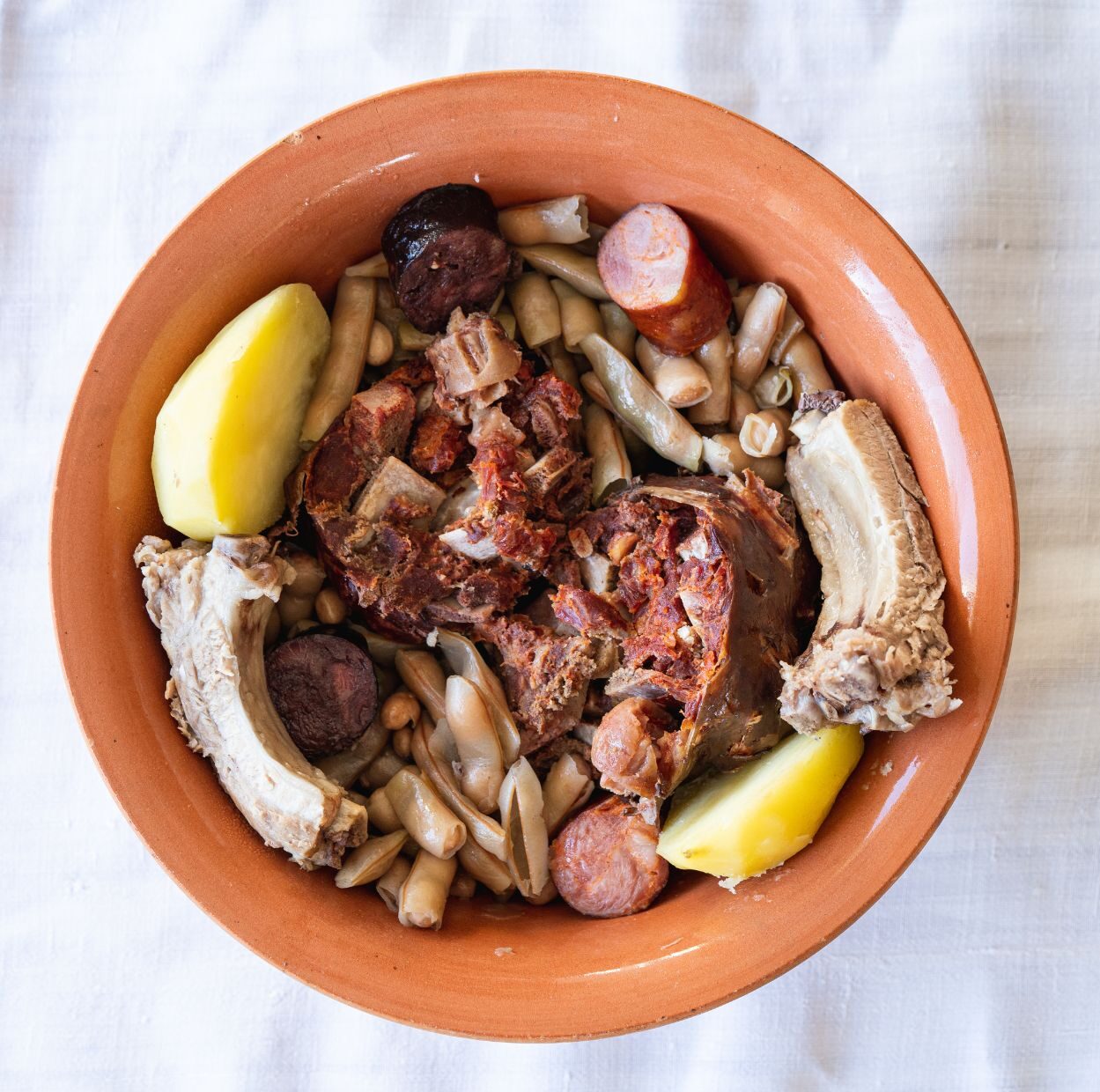
‘Butelo com casulas’
If there’s one enchido that even has a whole dish named after itself, that is butelo com casulas,
also from Trás-os-Montes. Sometimes also named cozido Mirandês (that is from Mirandela, where this sausage comes from), this is a boiled dish featuring boiled butelo and other meats like cured ham and assorted enchidos, ribs and pork ears. The meats are served with boiled potatoes and casulas (or cascas), which are essentially sun dried bean pods which are rehydrated during the preparation of this recipe and seasoned with olive oil. This is not at all a common dish outside of this northern province, but it certainly is a good excuse to travel to the region of Mirandela in Trás-os-Montes!
Enchidos may be mostly featured in stews, but their use isn’t certainly limited to them. A typical caldo verde serving, Portugal’s most popular soup with shredded collard greens, wouldn’t be complete without a slice of chouriço as garnish. Chouriço and other enchidos like morcela and cured pig’s ear are also used to make sopa da pedra, Portuguese “stone” soup with assorted vegetables, tubers, beans and meats. Also a beloved appetizer, ovos com farinheira, features scrambled eggs with shredded farinheira, something we eat as a petisco before a meal or as a snack (certainly not breakfast). Moreover, even baked dishes such as arroz de pato (duck rice) wouldn’t manage to have such a rich tasting crust without slices of this same paprika infused enchido on top.
Other typical Portuguese dishes including cured meats and charcuterie may also include cataplana (such as clams and chouriço cataplana), a preparation cooked inside a clamshell shaped cooking vessel, where ingredients like seafood, meats and vegetables are steamed.
Portugal is quite big on savory breads, and enchidos are usually responsible for bringing flavor to these baked goods.  The range of Portuguese cold cuts stuffed breads includes pão com chouriço (buns baked with slices of chouriço inside), merenda or lanche (a slightly sweet brioche like bun with a filling of ham, cheese and chourição), bôla de carnes (similar to a lanche but family sized, usually with higher quality enchidos) and the mighty folar de carnes, also known as folar de carnes transmontano or folar de Valpaços (rich leavened dough with a great variety of enchidos, like chouriço, cured ham, smoked bacon and salpicão). If you would like to try one of these at home check our Portuguese recipe here!
The range of Portuguese cold cuts stuffed breads includes pão com chouriço (buns baked with slices of chouriço inside), merenda or lanche (a slightly sweet brioche like bun with a filling of ham, cheese and chourição), bôla de carnes (similar to a lanche but family sized, usually with higher quality enchidos) and the mighty folar de carnes, also known as folar de carnes transmontano or folar de Valpaços (rich leavened dough with a great variety of enchidos, like chouriço, cured ham, smoked bacon and salpicão). If you would like to try one of these at home check our Portuguese recipe here!
Surprisingly for many, even Portugal’s sweets may include enchidos. We’re talking specifically about pudim Abade de Priscos, a recipe which originated in Braga, in the north of Portugal, which includes copious amounts of sugar and egg yolks (a commonality of most Portuguese conventual desserts) and a piece of toucinho, that is smoked pork belly, aka bacon, responsible for adding a luscious decadent touch for this dessert.
Essentially, when you’re a Portuguese person, you’ll usually keep enchidos in your fridge or pantry, as they tend to be a great addition to so many dishes without a well defined recipe: think rices, soups, stews or oven omelets!
Where to eat Portuguese sausages in Lisbon
If your stay in Portugal allows you time and flexibility, we’d highly encourage you to get out of Lisbon and explore the Alentejo and Trás-os-Montes regions, where heading to small villages will grant you the delicious opportunity to taste variations of the sausages and cured meats we explore here today.
Each February, the Trás-os-Montes town of Vinhais becomes the “capital do fumeiro”, that is the main city for all things smoked, something promoted during their annual smoked sausages fair, which enjoys stupendous popularity across Portugal.
But you don’t certainly need to leave Lisbon itself to eat incredible enchidos. You’ll taste them when you order some of Portugal’s most traditional dishes at typical restaurants, or when you sit down at a tavern or wine bar to enjoy a glass of wine with a charcuterie and cheese board. During Oh! My Cod’s Original Lisbon Food and Wine Tour we also share with our guests a beautiful example of presunto de porco Bísaro, high-quality cured ham prepared with this breed of pig from the north of Portugal.
To sample delicious Portuguese charcuterie while in Lisbon, we recommend visiting the following establishments:
Comida Independente
?Rua Cais do Tojo 28, 1200-649 Lisbon
Genuíno – Atelier do Presunto (which specializes in cured ham, to eat-in or take-away)
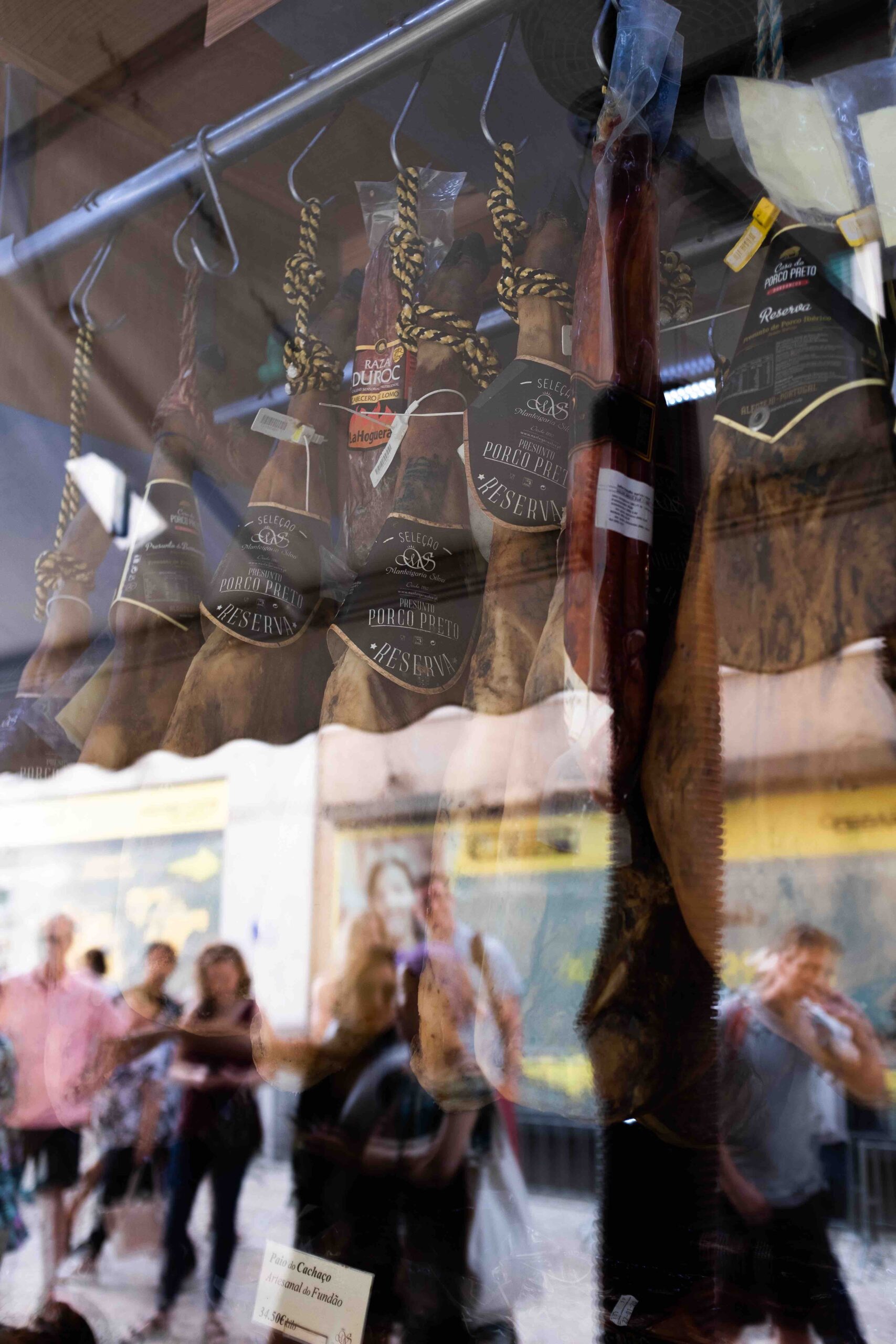
Photo by Mariuz Kiepura, during one of our Ethnographic Food Experiences
?Rua Silva Carvalho 52 C, 1250-254 Lisbon
By the Wine (for a glass of wine and a Portuguese charcuterie board)
?Rua das Flores 41 43, 1200-193 Lisbon
Nova Pombalina (for simple but high-quality sandwiches featuring some of Portugal’s best enchidos)
?Rua do Comércio 2, 1100-321 Lisbon
www.facebook.com/anovapombalina
If you plan on taking some Portuguese enchidos back home, these are some of our favorite stores in Lisbon to buy cured meats:
Manteigaria Silva
?Inside Time Out Market and also at: Rua D. Antão de Almada 1 C e D, 1100-197 Lisbon
https://manteigariasilva.pt/index.php/en
Charcutaria Riviera
?Av. da Igreja 23, 1700-231 Lisbon
www.facebook.com/rivieralisboa
Manuel Tavares
?Rua da Betesga 1AB, 1100-090 Lisbon
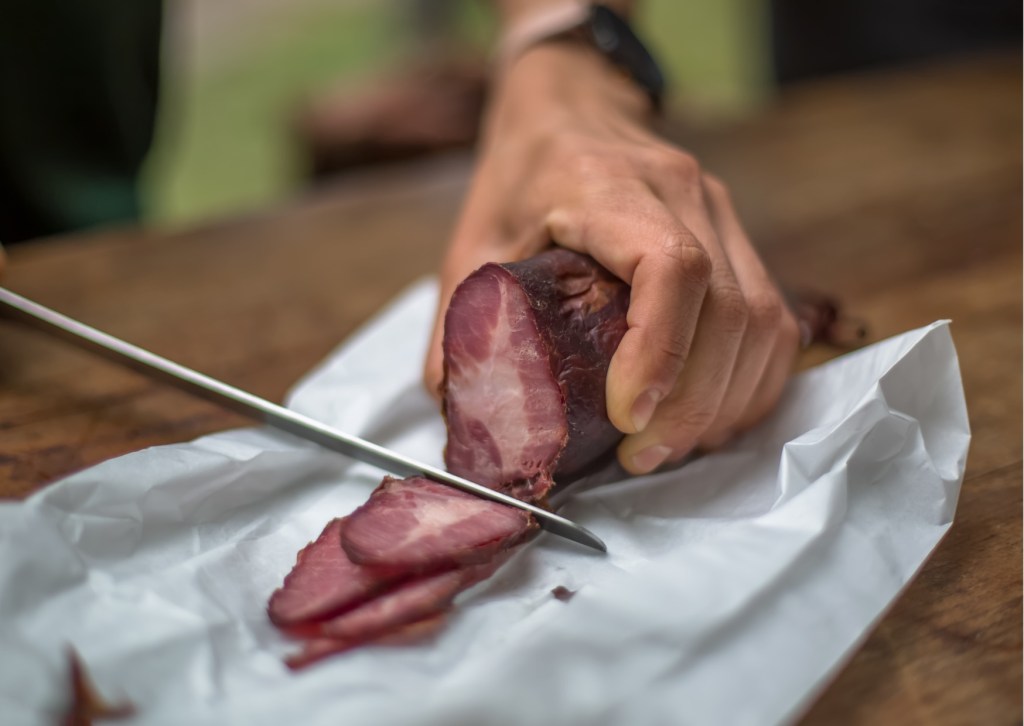
Black pork ‘cachaço’ is a delicatessen and can be purchased at Manteigaria da Silva, in Lisbon.
Article by :
Zara Quiroga (freelance food writer and food & cultural leader at Oh! My Cod Pico Trips)
Photos by:
Sílvia Olivença (anthropologist and food guide/CEO at Oh! My Cod Ethnographic Food Tours & Trips)
Want to more about Portuguese cuisine and its influences?
Pico Wine: one of the world’s most unique wine regions (Genesis – Part I)
Alentejo and Algarve: culinary traditions of the South of Portugal
10 Portuguese Codfish recipes step-by-step
Minho, Douro and Trás-os-Montes: the cuisines of Northern Portugal (includes Porto!)
How Portugal influenced Indian cuisine
